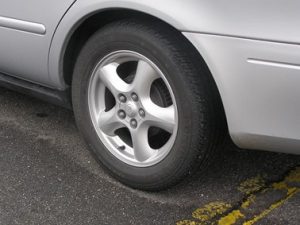 Cars are essential for modern life, yet many drivers greatly underestimate the importance of regular vehicle maintenance. It’s especially easy to forget about your tires. You can drive for thousands of miles on deteriorating tires without noticing a thing. However, poor tire quality will eventually cause serious problems. If you care about your car’s safety, ride quality, or handling ability, you need to pay close attention to the tires’ condition. Read this guide to learn how to care for your car’s tires properly.
Cars are essential for modern life, yet many drivers greatly underestimate the importance of regular vehicle maintenance. It’s especially easy to forget about your tires. You can drive for thousands of miles on deteriorating tires without noticing a thing. However, poor tire quality will eventually cause serious problems. If you care about your car’s safety, ride quality, or handling ability, you need to pay close attention to the tires’ condition. Read this guide to learn how to care for your car’s tires properly.
Quick Facts About Tire Safety
The average American drives 13,000 miles a year, and the number is growing. With so much time spent on the road, it’s a good idea for everyone to learn how to maintain their tires.
Data from the National Highway Traffic Safety Administration indicates that thousands of traffic accidents are caused by tire failures. By neglecting to follow standard tire care tips, drivers set themselves up to face negative consequences. These consequences may have been avoided completely if the driver devoted just a few minutes a week to inspecting their car’s tires.
What Happens If You Ignore Your Tires?
Your car’s tires are the sole part of the vehicle that makes direct contact with the road, so they need to be able to withstand a lot of wear and tear. Tires that are overinflated, underinflated, punctured, or misaligned can all cause problems for your vehicle. Here’s what might happen:
- Sudden blowout: If the tire is underinflated, or the tread is too worn, you’ll experience poor traction while driving, which could lead to the rubber disintegrating and the tire blowing out.
- Steering problems: When your wheels are misaligned, steering straight becomes more difficult.
- Poor handling: If your tires are in poor condition, your vehicle has to work harder to stay on the road.
Ideally, your car’s tires will be regularly checked for balance, wheel alignment, tread depth, and air pressure. If you team up with a dealership or service room staffed by skilled technicians, your tire maintenance routine shouldn’t require more than an hour or so of work per month.
How Can I Tell When It’s Time to Change My Tires?
When there’s a glaring issue like a flat or punctured tire, you already know what you need to do — find a replacement. However, there’s another, subtler sign that your tires are in trouble: tread damage. By familiarizing yourself with what this sign means, you’ll be able to figure out when it’s time to replace your tires before they’re completely destroyed. This reduces the chance that your car’s poor-quality tires will involve you in an accident.
So, if you want to gauge the state of your car’s tires, here’s what you need to do:
- First, turn your car off and take a look at the tread. If the tire’s tread is in bad shape, it’s not a good sign. The tread wears down with time and use, so it needs to be routinely monitored.
- Next, grab a penny. Turn it so Abraham Lincoln’s face is points down and insert the coin into the tire’s tread.
- Finally, look to see how much of Lincoln’s face is covered. About half of the face is hidden on a pristine set of tires. If you’re looking at Lincoln’s entire head, however, it’s time to replace your tires.
Extensive tire wear isn’t the only sign that your tires are damaged, although it is one of the easier signs to recognize. Here are a few other things to look out for:
- Strange noises or vibrations: An unusual noise or noticeable vibration while driving could signal a problem with the tire belt, the tire’s tread, or the tire’s balance.
- Pulling to the side: If you notice your car pulling to one side, you might be dealing with a wheel alignment problem or an underinflated tire on one side.
How Often Should I Change My Tires?
Exactly how long your car’s tires will last depends on various factors, including the climate that you’re driving in and how often you drive.
In general, you should change your tires whenever the tread is so worn down that you fail the penny test mentioned in the above section. According to Kelley Blue Book, new tires, on average, will last for 25,000 to 50,000 miles or six years. Once your tires are six years old, you should replace them even if you don’t see visible damage.
To figure out how old your tires are, take a look at the four-digit Department of Transportation (DOT) code stamped on the tire wall. The first two numbers represent the week of the year that it was manufactured, while the other two numbers represent the year itself. So, if your tire’s DOT code is 1218, it was made in the 12th week of 2018.
My Tires Need Attention — What Next?
When you notice that your tires need attention, you need to take action immediately. Don’t delay, even if you think the issue is minor. An unexpected blowout could potentially have serious consequences.
There are several tire maintenance tasks that you can perform yourself. For instance, you can fill an underinflated tire at a gas station with an air pump. If you have a spare handy and need to install a replacement tire, you might be able to do that yourself as well.
However, many aspects of your car’s tire care routine should be handled by a professional. If your tires need to be rotated or you need alignment services, you should visit a dealership. These are critical tasks if you want your tires to last as long as possible. A skilled technician can get you back on the road quickly and safely.
If you’re looking for a respected dealership in the Lewisville, Texas, area to service your vehicle’s tires, give us a call at Huffines Chrysler Dodge Jeep Ram Lewisville. You can reach us at 972-538-4100 or schedule an appointment online. Our team offers affordable, top-notch tire care services that you can depend on.
Image via Flickr by robmba




